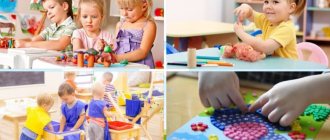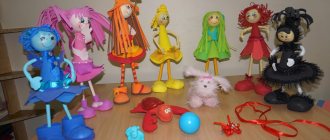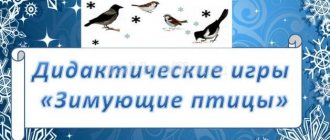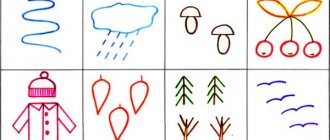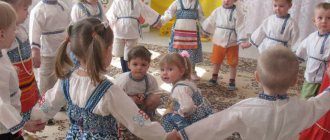Didactic games for speech therapy classes with preschoolers
Speech therapy educational games for preschoolers
Educational games Author: Tatyana Vasilievna Chervyakova, speech therapist, MDOU kindergarten “Rodnichok” Description: The presented didactic games will be useful for speech therapists and kindergarten teachers. The material is intended for conducting individual and subgroup speech therapy sessions with preschoolers.
Purpose of the game: to activate vocabulary on the topic “Vegetables” and “Fruits”; Teach children to divide words into syllables. Material: drawings: planar images of baskets with syllabic patterns, images of objects - vegetables and fruits. Progress of the game: Speech therapist. Guys, today we are going to visit our grandparents in the village to see what vegetables have grown in the beds. – And then our grandparents meet us.
Speech therapist. Grandma invites you to guess what vegetables they collected. – round, red, juicy, healthy, soft... (tomato) – oval, green, crunchy, rough, hard... (cucumber) – oblong, orange, hard, tasty, vitamin... (carrot) – round, bitter, hard, healthy ... (onion) - round, green, juicy, crispy... (cabbage)
Speech therapist. Guys, you guessed all the vegetables. Now let's put them in baskets. – Notice what beautiful baskets grandma prepared. Each basket has a syllabic pattern. Let's name the vegetables one by one, determine the number of syllables in each word and put the vegetable in the correct basket.
A similar game can be played on the theme “Fruits”. As material we use images of objects - fruits.
Didactic game “Syllable Houses” Purpose of the game: to teach children to break words into syllables. Material. Airplane images of houses with window pockets. Every house has a syllabic pattern. Images of objects depicting fairy tale characters: Wolf, Carlson, Dunno, Pinocchio, Malvina, Puss in Boots and others. Progress of the game. Speech therapist. The heroes of fairy tales came to visit us. Nominal. Child. Wolf, Carlson, Malvina, Pinocchio, Aibolit.
Speech therapist. Guests should be “settled” in houses. Determine the number of syllables in each word and “place” the hero in the desired house.
Child (speak and emphasize the syllables) - “Karl the Son” - two syllables (puts the photo in the pocket of house No. 2) - “Wolf” - 1 syllable (puts the picture in the pocket of house No. 1).
- “Mal-vi-na” - this word has three syllables (puts the picture in the pocket of house No. 3) - “Bu-ra-ti-no” - the word has four syllables (puts the picture in the pocket of house No. 4)
Speech therapist. Very good! The manual can be used when studying other lexical topics.
We recommend watching:
Speech therapy games for preschoolers Games for the prevention of optic dysgraphia and dyslexia in preschoolers Speech therapy games for kindergarten using animals Do-it-yourself speech therapy board games for kindergarten
Similar articles:
Speech therapy games for preschoolers and primary schoolchildren
DIY speech therapy games for preschoolers
DIY speech therapy games
Speech therapy game for older preschool children
Speech therapy game for children 5-8 years old “Who is faster”
Game aids and material for speech therapy sessions
Contained in sections:
- The work of a speech therapist. Speech therapy 8472
Includes sections:
- Differentiation, automation of sounds. Didactic games 392
- Breathing exercises. Homemade games and manuals 449
- Speech development. Speech games, teaching aids 3384
- Tongue. Speech therapy visual and didactic aids 14
By groups:
- Senior group
- Preparatory group
- Middle group
- Junior group
Showing publications 1-10 of 1446. All sections | Speech therapy games
New
Photo
The best
Workshop for teachers “Speech therapy games using non-traditional material”
Workshop for teachers “ Speech therapy games using non-traditional materials” Prepared by: teacher-speech therapist Belaya K.A , MBDOU kindergarten 35, Krymsk, Krasnodar region The use of non-traditional materials in speech therapy classes is a powerful incentive...
Didactic manual “Speech therapy mat”
During speech therapy work in children with a number of speech disorders, there is a pronounced lag in the development of phonemic hearing and phonemic perception. There are also difficulties in mastering the merging of letters into syllables, syllables into words , dividing words into syllables, as well as in different...
The role and significance of speech therapy games
The process of further development of the child depends on how well the speech is formed. That is why it is so important to promptly prevent various defects and monitor the purity of the sounds produced by the baby. Violations are noted not only in the speech of a preschooler, but also in perception and production itself. When determining the degree of the defect, all symptoms associated with mental, physical and speech development are identified.
Language educational games
Note! Play is the main activity of a child; with its help, he masters various forms of thinking and develops his horizons. Speech therapy games play an important role in creating a favorable environment for a child to overcome speech disorders of varying severity.
Speech therapy educational games for preschoolers have great potential: with their help, the student works on correct pronunciation of words, learns their native language and learns the rules of grammar in a simple form. Difficulties overcome in this way in a playful way are less obvious and tangible for the child.
The main significance of speech therapy games is to increase the vocabulary and horizons of children, expand the boundaries of the child’s consciousness and introduce him to the world around him.
How games help a speech therapist
Every year the percentage of preschool children with speech pathologies of varying complexity and etiology increases. To correct standard speech disorders, you need to practice at least 2-3 times a week for 30 minutes. However, it is difficult to captivate children with a monotonous task; they quickly get tired and refuse to complete the exercises suggested by the teacher. To increase motivation for learning, speech therapists use game techniques in their classes, thanks to which the correction process ceases to be boring for the child.
What else to read: Board educational adventure game “Zoo from A to Z”
Speech therapist and child
Games to develop articulation and onomatopoeia
Their principle: from sound to word, from word to phrase.
For normal pronunciation of sounds, you need a good articulatory apparatus. Defects in pronunciation that arise in childhood are very difficult to correct later. Therefore, the articulatory apparatus also requires gymnastics. Game “Chicks”
The teacher says to the child: “Look at the chicks! How do they squeak? The child answers by imitating the chicks. “What are they asking for? Pee-pee-peeit.” It is necessary to “water” the chicks.
Speech therapy games with a flashlight for children
Games with light are spectacular and exciting, and the flashlight is accessible and safe for children. The game was developed by teacher Natalya Konyakhina. For the game you will need sheets of paper from which the box will be made. You will also need drawings that can be printed on a printer or downloaded from the Internet (shoes, clothes, fruits, vegetables, animals and any other items studied in preschool). Items need to be cut out and glued inside the box so that the front side faces the baby. The child points a flashlight at the wall and answers the questions: “What do you see?”, “Whose shoes are these?”, “Is there an apple in the box or many?”
Underdevelopment of phonetic-phonemic speech in preschool children
Note! Games with a flashlight make it easy for a preschooler to develop coherent speech.
Child with a flashlight
Didactic games for the development of speech of preschoolers card index on speech therapy on the topic
Reminder for parents
“We talk, we play – we develop our discourse”
DEAR PARENTS!
Talk to the kids!
There is a lot of talk about how good language development is a prerequisite for academic success. However, parents do not always know how to develop this speech.
You can often hear: “We read a lot to the child, read poems, talked about everything, but there was no result; The child himself cannot describe the simplest image or tell anything.”
How could it be otherwise: after all, it was the parents who said it, not the child. Babies are all different - some are unstoppable, while others say nothing. But even the “silent” will speak if there is an incentive to speak out.
The performance begins with the desire to communicate!
No matter how imperfectly your child speaks, accept his desire and indulge him. Even if he doesn't speak at all, often engage him in nonverbal dialogue, welcoming and approving any response (gesture, expressive look). At the same time, try to give him the opportunity to listen to himself and himself. Especially create play situations where the child will need onomatopoeia or will have to say a few words for the game to take place. Keep in mind that it is not you who motivates, but the situation. Mood.
Try to pronounce a new word in an emotionally favorable situation: when the child is calm, in a good mood, in such conditions the child assimilates and assimilates information 10 times better than neutral or unfavorable information.
How can you develop speech?
1. Whether you are looking at an image, reading a book, draw your child’s attention to rare phrases, ask what this or that word means.
2. Play the game “Tell Me the Word”: an adult reads a short poem, and the child must guess and name the last word in it.
3. Play with words. This can make a long journey in transport, or the need to lie in bed, cheer up. These tasks include:
- what words, colors can describe the time of year, tell about the topic, what it is about (quote as many adjectives as possible);
- what he can do (name as many verbs as possible)
- play a bad and a good game. What is good about Baba Yaga and what is bad? What is good in the rain and what is bad?
- play opposite words (opposites)
4. Invite your child to tell a story, story, or cartoon. Ask what you liked and why. Ask to describe your favorite character.
5. Play the game: “Find the error in the sentence”
6. Teach your child to make a story from an image. Explain that a story has a beginning (as short as the morning), a center (as the day), and an end (as short as the evening).
7. Play a familiar fairy tale face-to-face with different intonations.
Remember! It's very easy to knock over a child. Treat your child with understanding.
Expand your child's vocabulary.
A child has words on two levels: he understands words - this is passive vocabulary, he speaks - he is active. The active vocabulary can be quite small. Try entering the names of things around it (toys, household items), the names of family and friends into the active dictionary. More often they ask: “Where is the table? Where's the clock? ”etc. This will certainly lead to an increase in vocabulary. Develop phonemic awareness (the ability to hear different speech sounds) by encouraging different sound words. (roof – mouse, nose – knife).
Read to your child.
Read short poems and fairy tales. Read them many times: don’t be afraid that your child will get tired of it. Children learn much better from texts they have already heard. If possible, try to quote the poem - show it with faces and objects; and let your child play with objects. Wait until the child has a good memory of the poem, get a feel for the rhythm, then try not to finish the last word of each line, allowing the child to do so. Sing simple songs to help him feel the rhythm and play it.
What else to read: Role-playing games as a means of developing older preschoolers’ ideas about adult professions
Fingers help the word.
Pay attention to the development of fine motor skills - precise finger movements. Modeling, drawing, finger theater, playing with small objects - all this will help speech, and in the future, writing. The child should work with naughty fingers as much as possible. No matter how boring it may seem, let the child button up his buttons, tie his shoelaces, and roll up his sleeves. It is also better to start training not with your own clothes, but first “help” the doll and even the parents get dressed. As a child's fingers become more dexterous, his speech will become more understandable to others. About the benefits of joint gymnastics in the development of a preschooler.
Joint gymnastics in the development of preschoolers.
Gymnastics for arms and legs is familiar to us. We train the muscles so that they become flexible, strong and agile. But why train? It turns out that the tongue is the main muscle of the speech organs. And like any muscle, it simply needs gymnastics. After all, the tongue must be well developed to make the subtle, intentional movements that produce speech sounds.
Pronunciation deficiencies aggravate the emotional and mental state of the child, preventing him from developing and communicating with peers. To prevent this problem from arising, you should start doing gymnastics for your joints now. With the help of articulatory gymnastics, existing violations of sound pronunciation are overcome.
At first, gymnastics should be done in front of a mirror. The child must see what his tongue is doing and where it is. In this case, the movements of the tongue are brought to automaticity by constant exercises. Work with your child every day for 5-7 minutes. Carrying out articulatory gymnastics in the form of a fairy tale (in a funny language) will help turn the exercises into an exciting game.
Believe in yourself!
Remember: only you and your faith in the child’s strengths and abilities can help him develop harmoniously. Be patient, kind and calm and you will succeed.
Development of fine motor skills to prepare the hand for writing.
It has now been shown that the development of fine motor skills of the fingers has a positive effect on the speech development of children. Employees of the Institute of Physiology and Adolescence of the Academy of Pedagogical Sciences of the Russian Federation determined that the projection of the hand to the brain is very close to the area of the speech motor. The relationship between the motor and speech zones is also manifested in the fact that a person who has difficulty finding a word helps himself with gestures, and vice versa: a child focused on drawing or writing involuntarily sticks out his tongue.
Therefore, training the movements of fingers and hands is the most important factor that stimulates the development of a child’s speech, helps improve articulatory movements, prepares the hand for writing, as well as a powerful tool that increases the performance of the cerebral cortex and, as a result, the level of development of thinking.
Activities that develop fine motor skills.
Have a beneficial effect on the development of hand and finger movements:
- massages and self-massage;
- finger gymnastics;
- visual activity;
- modeling;
- drawing;
- statement;
- handmade;
- manipulations with various objects: collecting pyramids, nesting dolls, builders, mosaics; unfastening and fastening buttons, Velcro, straps; lacing.
- shading, writing.
Games and exercises for children 2-4 years old.
Magic bag.
Examine toys and objects with your baby and touch them. Invite your child to touch one of the items in the bag, name it, and pick it up. Without removing the object, touch it, name it and describe it.
Tactile tables.
it is necessary to prepare a series of boards with different structural surfaces; with images of various objects cut out along the contour.
Tasks: with eyes closed, feel the outline and name the depicted object; find a specific image of an object with your eyes closed; find two identical cards.
Finger pool.
Tasks: lower your hands to the pool of fingers and touch the beans or peas; move to another container one by one; clench and unclench fists with beans and peas while holding hands in the pool; touch this object.
I turn and turn.
(Tasks with various massage balls, sticks, chestnuts, nuts, etc.)
Throw and grab an object with one hand, two hands, unfold an acorn or pine cone. Roll a massage ball or stick: with your palm, the edge of your palm, the finger of one palm towards the other, between your palms, on the back of your hand with rotational movements in one direction, in the other direction, vertically. Gradually increase pressure and rotation speed.
Rope.
Tasks: tie and untie knots; twine: remove the beads, twist the lace between the tips of the thumb and forefinger, wind the lace on a stick or thread on a spool, braid a pigtail, intertwine fingers with lace, decorate patterns and figures with lace.
Clothespins.
Tasks: use clothespins to hook a sheet of paper, the edge of a box or cup, or a rope; open and close the clothespin with your thumb and index finger, thumb and middle finger, etc. Ask your child to count the number of clothespins on the string, and only put clothespins of a certain color on the string.
What else to read: Didactic game “Berry, Vegetable or Fruit?” 5-6 grade
Exercises with vocal accompaniment.
Fox.
Rhythmic opening and closing of a clothespin while pronouncing the text:
“Clever scammer, redhead. The mouth opens, it scares the rabbits.”
Crow.
Bend your hand towards the table and take the candy wrapper. Then the brush returns to its original position. Talk:
“I saw the paper and how to take it. I thought it was candy, but it turned out to be a candy wrapper.”
Dogs.
The exercises involve both hands, which rhythmically open and close clothespins while pronouncing the text:
“Two dogs bark, don’t bite. Two cubs walk around in the nest all day, screaming, opening their mouths to the crows, and really want to eat.”
For children 5-7 years old.
Finger gymnastics, games with letters and words. As a physical exercise, it is very good to use finger exercises with speech accompaniment. The dictionary has dozens of poems on every topic. For example:
The sky in Russia is blue
The rivers in Russia are blue – they bend like your finger.
There are maples and oaks, the fingers represent “branches”
What kind of mushrooms are there? The fist of one palm is covered with the other open palm.
Children love to speak in a secret language. Create your alphabet with your fingers. Use it to guess letters and then form words. [2]
Arrange the figures, counting sticks and matches.
Finger Theater. They develop attention, thinking, memory, stimulate the baby’s speech development, help relieve tension from the hands and lips, relieve mental fatigue, develop arms, become more mobile and flexible. Advise parents to take their children to a real theater to see various children's performances.
Written works, various types of shading, coloring of figures, pictures.
Currently, there is a large selection of literature on this topic. You can purchase it to your liking, but make sure the instructions are appropriate for your child's age and difficulty level.
How to conduct classes at home
For many children, homework is much more fun than with a specialist. The child sees his mother or any other person he knows and feels safe. To get the most out of your lessons, you can purchase special guides that not only explain in detail how to set up and automate each sound, but also record the results. An example is N.V.’s speech therapy notebook. Sokolova.
Methods for correcting general speech underdevelopment in preschool children
For your information! Initially, speech therapy games should be accompanied by a voice explanation from an adult. After this, only the child should speak (or try to speak.
Speech therapy games for setting the sounds Ш and Ж
These sounds require a flattened position of the tongue, with the tip pressed against the upper palate. This can be achieved using the following exercises:
- "Shoulder". Stick out your wide tongue and place it on your lower lip.
- "Brush". Run the tip of your tongue from your teeth to your throat and vice versa.
- "Delicious jam." He licks his upper lip as if licking sweetness.
Speech therapy games for setting the sounds L and R
Both sounds require tension of the tip of the tongue against the roof of the mouth. However, the exercises for setting up sounds will be different.
Setting the “L” sound:
- "Punish your tongue." Extend and spread your tongue over your lower lip and lightly bite it with your upper teeth, making a “roo” sound.
- Alternating “spatula” and “back”. The tongue is spread over the lower lip or tense and is in the middle of the half-open mouth.
- "Horse". The purpose of this exercise is to teach the child to click by pressing the tongue against the alveoli behind the upper teeth.
Setting the "R" sound:
- "Car". Open your mouth wide, press your tongue against the upper tubercles and quickly say “ttt”, simulating automatic fire.
- "Brush your teeth". Run your tongue behind your upper teeth to the right and left.
- "Swing for children." Open your mouth and place the tip of your tongue directly on your upper lip, then on your lower lip.
Speech therapy games for setting the sounds Z, S and C
Normally, a child pronounces whistles correctly at 4 years of age. Exercises to help reproduce these sounds:
- Alternating a smile with the “Tube” exercise. Smile widely, hold this position for a few seconds, then purse your lips.
- "Pendulum". Open your mouth and point the tight tip of your tongue from the right to the left corner.
- "Slide". Place the tip of your tongue on your lower teeth and lift the middle palate above the upper palate, forming a cusp.
Important! When explaining the exercise, be sure to have a tabletop mirror with you, in which the child will see his reflection.
Each exercise must be repeated six times, the total execution time should not exceed 2-3 minutes. When trying to correct the situation, do not put a dirty hand in your baby’s mouth. If it is not possible to purchase special tools for a speech therapist (spatula), in case of forced contact with the child’s oral cavity, you can use a teaspoon, first sterilized in hot water.
Mirror in speech therapy games
Any deviations in the normal pronunciation of sounds can create a lot of inconvenience for a child of preschool and primary school age. A 6-7 year old child compares his speech with the speech of other children, and if there are defects, he begins to be embarrassed, withdraws, and is reluctant to make contact. This prevents him from building normal relationships with peers and learning, because studying in elementary school is inextricably linked with speech functions.
A speech therapist and a child psychologist can help a child overcome difficulties. Many parents themselves take an active part in correcting their child’s speech, working with him at home. In this material we will present several of the most effective speech therapy games for preschoolers.
When is homework needed? Preschoolers who have problems with sound pronunciation undergo a speech therapy examination in kindergarten or early development school. During this unusual diagnosis of speech abilities, the speech therapist finds out how early the baby began to speak, what words were the first, when he learned to form sentences, whether he has speech defects and difficulties with pronouncing certain sounds.
The following sounds and combinations are usually studied: C, Сь, З, Зь, Ц, Ш, Ж, Шч, Х, Р, Рь, Л, Ль. Not only individual pronunciation is assessed, but also their sound in words and syllables.
The speech therapist also evaluates the functioning of the child’s articulatory apparatus, his bite, the condition of his teeth, tongue, and lips. And only after that all data is entered into the speech card. It also includes the specialist’s appointments.
In addition to visiting a speech therapist’s office in a group or individually, parents are recommended to work with their preschooler at home. It is precisely these homework activities that raise a lot of questions among parents.
How to structure a lesson The optimal form of learning information for children 6-7 years old is a game form. At this age, boys and girls have a need not just for games, but for plot and role-playing tasks in which they can try themselves in different roles. This must be taken into account when planning home speech therapy sessions.
They should be done daily, spending at least 10-15 minutes. Ideally, you should work with your child three times a day for 10 minutes.
It is advisable to include the following components in each lesson:
warm-up (gymnastics) for the speech apparatus - 3-5 minutes; logorhythmics (pronunciation of problematic sounds in rhymes and simple phrases) synchronously with movement, in time with jumping or walking - 1-2 minutes; breathing exercises with pronunciation of problematic sounds as you exhale (1-2 minutes); poems and songs, can be combined with movement, colored with emotional facial expressions and gestures (3-4 minutes); speech therapy games with didactic material (4-5 minutes); new exercises - demonstration and repetition (2-3 minutes). As you can see, it won't take much time.
In addition to the obvious benefits for speech development, such joint activities and games will benefit communication between adults and children; they help to better understand each other and establish trusting relationships.
Exercises for the speech apparatus Articulatory gymnastics can be a very funny and entertaining pastime. Parents can invite the child to stick out his tongue like a snake, “hang” it down like a tired dog, with his tongue hanging out, you can draw something in the air so that the mother tries to guess what the child has drawn. The lips are folded into a tube, depicting an elephant and a fish, stretched into a wide smile, and teeth bared, like an angry lion.
Such simple exercises well develop facial muscles, muscles of the lips, tongue, jaw, and also improve the mood of both children and adults. If you accompany articulatory gymnastics with funny sounds that complement the animal being depicted, then fun is guaranteed for everyone.
Tongue twisters and pure twisters The value of tongue twisters is difficult to overestimate. They do not allow the child to miss a sound in a word, the pronunciation of which is difficult for him, and to replace it with a similar but different sound.
Mom and dad can easily compose simple sayings on their own. To do this, the beginning and end of a rhymed couplet or quatrain include the sound or combination of sounds with which the child most often has problems.
For example, a preschooler with a problem with “L” will have a much better pronunciation if, in rhythmic activities, when walking, jumping, or dancing, he pronounces a clear phrase for this sound:
La-la-la winter has come,
I whitened the paws of the Christmas trees,
I bound it with ice, covered it with ice,
The forest was bewitched.
Pure tongues with an abundance of such sounds will help your child cope with problematic hissing sounds:
Shchi-schi-schi go look for it
Shu-shu-shu I put out the fire
Cha-cha-cha give me the roll.
The sound R, which is difficult for a large number of preschoolers, can be dealt with if you regularly use the following phrases:
Ra-ra-ra, ra-ra-ra it’s hot outside the window,
Re-re-re, re-re-re let's take a walk in the yard.
When choosing tongue twisters, you should also pay attention to the sounds and combinations of sounds that predominate in them. Thus, the well-known “Sasha with dryers” will help with defects in the pronunciation of hissing sounds.
To train “R,” you can emotionally recite a tongue twister about an otter in spats who collects cedar kernels in the depths of the tundra, or a poem about a crayfish in the river and an unlucky Greek.
To learn the correct pronunciation of “L”, you can recall the story of a bell not cast in the Kolokolov style.
The complexity and pace of pronunciation of tongue twisters should be increased gradually, starting with a couple of sentences at a slow pace and ending with a couple of quatrains at a competitive pace - who can pronounce it faster without errors.
Games and tasks Activities for home are well complemented by games using pictures. They will not only help develop speech, but will also have a beneficial effect on the development of imagination, the ability to compose and construct stories and express one’s thoughts. For the next lessons you will need to print the following pictures on regular A4 sheets.
If they are black and white, you can first color them with your child, because drawing, like writing, develops fine motor skills and stimulates speech development. As soon as the pictures are ready, we start playing.
“Snow Tale” A game for developing the pronunciation of sibilants, as well as “Z” and “S”. The Snowman and the Snow Maiden are going on a trip. They need to pack their bags. The child’s task is to send each of the characters a circle of paper with an object glued or drawn on it.
The Snow Maiden collects only objects that contain the sounds “Sh”, “Zh”, “Shch” and “Ch”, and the Snowman collects only those circles that depict objects whose names contain “S”, “Z”.
For circles you can use the following words and images - sun, umbrella, fur coat, hat, brush, cup, sundress, bag, mittens, scarf, watch, dog, suitcase, sweater, castle, bunny and others.
“Zina the Sweet Tooth” For this game, for the picture of a girl with a sweet tooth, you should cut pieces in the shape of candies from ordinary landscape paper. Each paper “sweet” has a picture of an object or animal with a problematic sound in its name.
If the child’s L and R are “lame”, then you can stick or draw on the “candy” a lion, lollipop, fish, crayfish, rainbow, leaves, lily, roses, kangaroo, shark, etc. As soon as the baby correctly pronounces the sound in According to the word drawn, the girl Zina gets a piece of candy.
“Piglet goes to visit” All preschoolers remember the story of Piglet, who went to visit with balloons. If you cut balloons out of paper and place images on them, the names of which contain sounds that are problematic for the child, then you can play with how many balloons Piglet can collect.
Each correct pronunciation of a sound is plus one ball for the pig. At the same time, the child will practice counting.
“Sleepy Pony” For the picture of a sleeping pony - the hero of the favorite cartoon of modern children - you will need to cut small clouds out of paper. Images of various objects, animals, and natural phenomena should be pasted onto them. The more such clouds there are, the better. The names of the pictures should contain the sounds that the child does worst. Elephant, tiger, rain, toad, wolf, apple, crocodile, fish, ball are just some of the options.
First, the child needs to answer the question of what the fairy-tale pony dreamed about. To do this, he must name each word legibly and repeat it to consolidate the result.
Then leave a few “clouds” and ask your child to come up with a dream plot. For example, you left a tiger, a lion, a rainbow and a crocodile. The child’s task is to compose a short story with these words. This could be the story of how the animals in the jungle saw the rainbow for the first time.
Support your child, help him, give him a chance to show all his imagination. Gradually, problem words will automatically become better.
Useful tips Parents should know the following points:
Practice only when the child is in the mood to play. You should not force your son or daughter to take speech therapy classes. Show more patience, encourage your child, don’t scold him, don’t demand immediate correct pronunciation. Compose and invent new games according to the scheme of the previous ones, let your favorite children's characters and heroes of games and cartoons appear in your games. Do not despair if at first the child complains of fatigue. Gradually, his speech apparatus will become stronger, and correct reproduction will become the norm, a natural process.

